
The Portable Antiquities Scheme (PAS) is a voluntary programme run by the United Kingdom government to record the increasing numbers of small finds of archaeological interest found by members of the public. The scheme began in 1997 and now covers most of England and Wales.

The Treasure Act 1996 is a UK Act of Parliament, defining which objects are classified as treasure, legally obliging the finder to report their find. It applies in England, Wales and Northern Ireland.
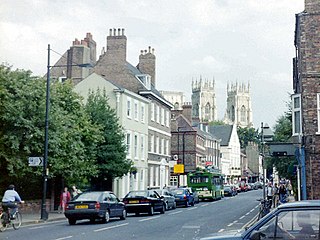
Bootham is a street in the city of York, in England, leading north out of the city centre. It is also the name of the small district surrounding the street.

A treasure trove is an amount of money or coin, gold, silver, plate, or bullion found hidden underground or in places such as cellars or attics, where the treasure seems old enough for it to be presumed that the true owner is dead and the heirs undiscoverable. An archaeological find of treasure trove is known as a hoard. The legal definition of what constitutes treasure trove and its treatment under law vary considerably from country to country, and from era to era.

The Cuerdale Hoard is a hoard of more than 8,600 items, including silver coins, English and Carolingian jewellery, hacksilver and ingots. It was discovered on 15 May 1840 on the southern bank of a bend of the River Ribble, in an area called Cuerdale near Preston, Lancashire, England. The Cuerdale Hoard is one of the largest Viking silver hoards ever found, four times larger than its nearest rival in Britain or Ireland, according to Richard Hall. In weight and number of pieces, it is second only to the Spillings Hoard found on Gotland, Sweden.

The Hoxne Hoard is the largest hoard of late Roman silver and gold discovered in Britain, and the largest collection of gold and silver coins of the fourth and fifth centuries found anywhere within the former Roman Empire. It was found by Eric Lawes, a metal detectorist in the village of Hoxne in Suffolk, England in 1992. The hoard consists of 14,865 Roman gold, silver, and bronze coins and approximately 200 items of silver tableware and gold jewellery. The objects are now in the British Museum in London, where the most important pieces and a selection of the rest are on permanent display. In 1993, the Treasure Valuation Committee valued the hoard at £1.75 million.
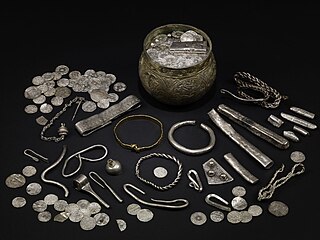
The Vale of York Hoard, also known as the Harrogate Hoard and the Vale of York Viking Hoard, is a 10th-century Viking hoard of 617 silver coins and 65 other items. It was found undisturbed in 2007 near the town of Harrogate in North Yorkshire, England. The hoard was the largest Viking one discovered in Britain since 1840, when the Cuerdale hoard was found in Lancashire, though the Anglo-Saxon Staffordshire Hoard, found in 2009, is larger.
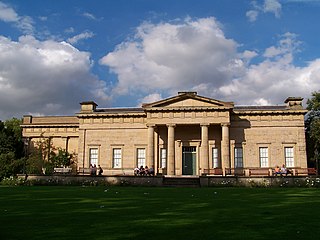
The Yorkshire Museum is a museum in York, England. It was opened in 1830, and has five permanent collections, covering biology, geology, archaeology, numismatics and astronomy.
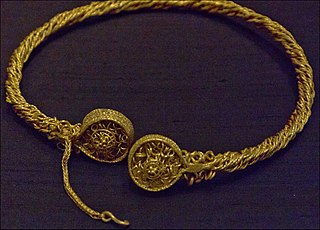
The Stirling torcs make up a hoard of four gold Iron Age torcs, a type of necklace, all of which date to between 300 and 100 BC and which were buried deliberately at some point in antiquity. They were found by a metal detectorist in a field near Blair Drummond, Perthshire, Scotland on 28 September 2009. The hoard has been described as the most significant discovery of Iron Age metalwork in Scotland and is said to be of international significance. The torcs were valued at £462,000, and after a public appeal were acquired for the National Museums of Scotland in March 2011.
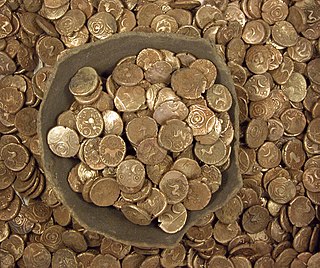
The Wickham Market Hoard is a hoard of 840 Iron Age gold staters found in a field at Dallinghoo near Wickham Market, Suffolk, England in March 2008 by car mechanic, Michael Dark using a metal detector. After excavation of the site, a total of 825 coins were found, and by the time the hoard was declared treasure trove, 840 coins had been discovered. The coins date from 40 BC to 15 AD.

The Silverdale Hoard is a collection of over 200 pieces of silver jewellery and coins discovered near Silverdale, Lancashire, England, in September 2011. The items were deposited together in and under a lead container buried about 16 inches (41 cm) underground which was found in a field by a metal detectorist. It is believed to date to around AD 900, a time of intense conflict between the Anglo-Saxons and the Danish settlers of northern England. The hoard is one of the largest Viking hoards ever discovered in the UK. It has been purchased by Lancashire Museums Service and has been displayed at Lancaster City Museum and the Museum of Lancashire in Preston. It is particularly significant for its inclusion of a coin stamped with the name of a previously unknown Viking ruler.

The St Albans Hoard is a large hoard of late Roman gold coins found by a metal detectorist in a field near St Albans, Hertfordshire, England in 2012. It is believed to be one of the largest hoards of Roman gold coins ever found in Britain. The hoard consists of 159 solidi dating from the last decades of the fourth century AD, near the end of the Roman occupation of Britain. After about 408, new Roman coins ceased to circulate in Britain, causing the collapse of the monetary economy and of mass-production industry.
Andrew R. Woods is a British numismatist, archaeologist and curator specialising in early medieval and Viking coinage. He is the senior curator of the Yorkshire Museum and was formerly the curator of numismatics at the York Museums Trust.

Elizabeth Jean Elphinstone Pirie was a British numismatist specialising in ninth-century Northumbrian coinage, and museum curator, latterly as Keeper of Archaeology at Leeds City Museum from 1960 to 1991. She wrote eight books and dozens of articles throughout her career. She was a fellow of the Royal Numismatic Society, president of the Yorkshire Numismatic Society and a fellow of the Society of Antiquaries of London.
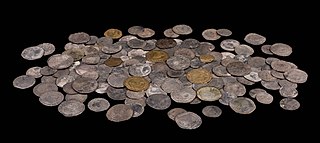
The Breckenbrough Hoard is a hoard of gold and silver coins dating from 1644, during the English Civil War. It is in the collection of the Yorkshire Museum.
The Cridling Stubbs hoard is a Romano-British hoard of more than 3,300 coins in a large, ceramic jar.

The Ryther Hoard is a hoard of coins found in a ceramic jug from Ryther cum Ossendyke, North Yorkshire, England.















